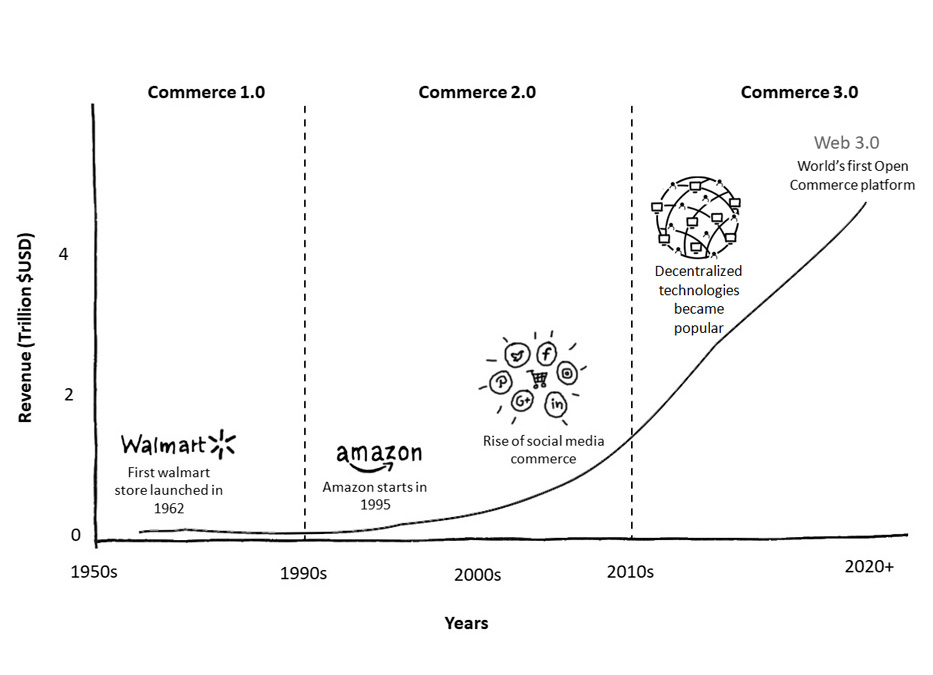Since the dawn of time, global commerce has been linked to economic development. From the Silk Road, which connected China and the Far East with the Middle East and Europe, to the rise of e-commerce, exchanging one product for another has had an indelible impact on the world.
Commerce has developed in three major phases, each generation using available technology to improve the failures of the last one. Each of these phases have led to the rise of some of the biggest companies, and while Commerce 3.0 is still in its infancy, I believe it holds the key to greatest value creation mankind has seen.

Commerce 1.0 – Centralized retail
Commerce 1.0 was the age of physical retail, the nostalgic era of Blockbuster and comic bookstores characterized by storefronts located near customers. While many small businesses grew in this era, the biggest winners were large retailers like Walmart and Costco who built chains of stores across the country and secured customer loyalty (coincidentally, this was when loyalty cards where invented).
However, the limitations of this model became apparent – all but the largest brands were limited to their immediate communities, and the cost of growth remained high.
Commerce 2.0 – Centralized E-commerce
The rise of the internet in the 90s ushered in Commerce 2.0 with its low cost, high scale e-commerce model that presented a new opportunity for sellers everywhere to grow their businesses, as they could now reach more customers and increase their income. This current era of commerce has created a few winners like Amazon and Alibaba who exert enormous influence on nearly every aspect of the commerce experience and take all the cake, leaving millions of small businesses and retailers struggling to survive.
Commerce 2.0 is killing sellers
The monopoly power centralized e-commerce platforms hold over retailers and small businesses is an indication that the current e-commerce business model is broken. By giving platforms all the power, brands and independent retailers constantly live in fear of their businesses evaporating overnight due to an algorithm change or direct competition from the platform itself.
For example, a close look at the retail business model of Amazon shows a startling conflict of interest. The company sells directly on Amazon.com, reaping the profits directly while simultaneously competing with independent third-party retailers who pay a referral fee and a percentage of all sales to sell on the platform. This model allows Amazon to function as a gatekeeper to their competition as it controls access to the online market while also exploiting and undermining small businesses. This is why 75 percent of independent retailers rank Amazon’s dominance as a significant threat to their survival.
Amazon isn’t the problem, centralization is. The centralized model will have sellers remain powerless and blindly trust the platforms they helped build – (P.S Trusting Bezos with your business, or Zuckerberg with your data is a VERY bad idea). However, commerce 3.0 is changing the narrative.

Commerce 3.0 – Decentralized commerce
Where Commerce 1.0 and 2.0 had large authoritative entities deciding how commerce works, Commerce 3.0 reconfigures the decision-making structure, removing the need for a central authority and the cost of the centralized middleman.
Open commerce is a main feature of Commerce 3.0 and is a system built on trust and transparency where brands and sellers can reach their customers directly, are free to choose how and where to deliver their products while also gaining full access to valuable data collated at POS. With decentralized open commerce, brands and sellers can sell their goods to anyone, anywhere without restrictions and at lower costs than centralized authorities.
Just as cryptocurrency revolution democratized money and made it possible for anybody with a mobile phone and internet to send, receive and hold money, even in the most remote parts of the world, we must create similarly decentralized platforms for commerce where merchants are in control and do not need to bow to large corporations that do not have their best interests. This is what we are building at RedCloud.
Creating a “sell anywhere” economy
RedCloud is the world’s first open commerce platform that puts power back in the hands of retailers and small businesses and allows them to engage in open frictionless commerce. With RedCloud, merchants across the world’s fastest-growing markets can connect with global brands directly or via any distributor, allowing them to run their businesses with more confidence and efficiency.
For merchants in emerging markets, signing up to RedCloud means that for the first time, they gain more access to more products, improved visibility into what is locally available, and for the unbanked majority, build up a digital profile.
I leave you with this final thought. By 2025, over 1 billion new merchants would be created to serve the 5 billion new middle-class consumers in emerging markets, a majority of whom will adopt online commerce. Which model do you think would be better for the world? One where merchants must pay exorbitant fees to reach their customers and live in fear of their businesses vanishing? Or a frictionless, ‘sell anywhere economy’, providing economic empowerment to the world’s next billion entrepreneurs, rather than the world’s next entrepreneur billionaire.
Expect Success.

